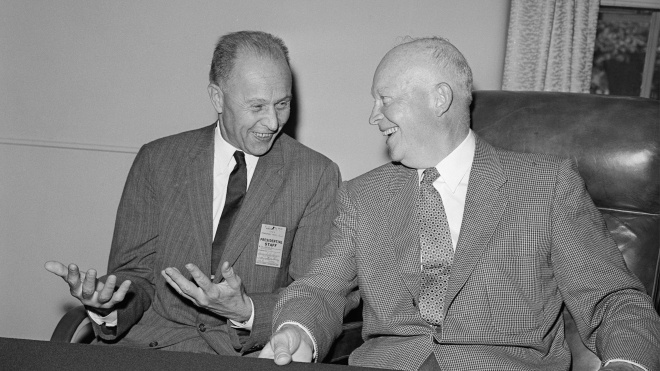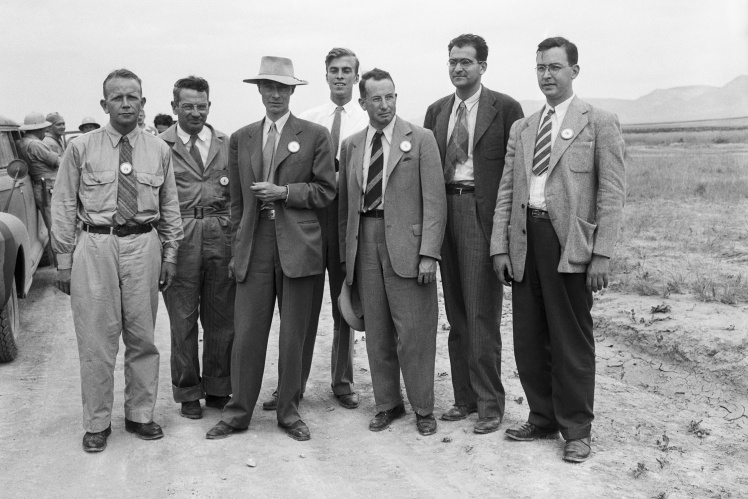Kistiakowsky was a scientist with combat experience. He was born in 1900 in Boyarka near Kyiv in a family of intellectuals, as Heorhiy Kistyakivskyi. His paternal grandfather Oleksandr Kistyakivskyi was a law professor and a well-known attorney specializing in criminal law. His father, Bohdan, was a professor of philosophy. During the tsarist times, he was considered politically inauspicious, and in 1919 he became a member of the Ukrainian Academy of Sciences. His uncle Ihor was the Minister of Internal Affairs in the government of Hetman Pavlo Skoropadsky. Heorhiyʼs brother, Oleksandr, became an outstanding Ukrainian ornithologist and headed the Department of Zoology at Taras Shevchenko Kyiv University.
After the Bolshevik coup, 18-year-old Heorhiy joined the White Movement and fought against the Soviet government. In 1920, escaping from the Bolshevik offensive, together with white emigrants, he sailed from Crimea to Turkey. He made his way through a camp for interned soldiers of the White Army and finally reached Paris in 1921. There, Heorhiy met his uncle Ihor, who also had escaped from the Bolshevik regime not empty-handed but with jewelry sewn into the lining of his clothes. This was enough for him to set up a law office and pay for his nephewʼs studies at the University of Berlin.
Heorhiy Kistyakivskyi (standing second from left), among the recipients of honorary degrees at the graduation ceremony of Harvard University, June 16, 1955.
Getty Images / «Babel'»
In 1925, Kistyakivskyi finished his Ph.D. thesis in physical chemistry. Due to the influx of migrants from the former Russian Empire in Western Europe, they were treated less and less favorably. Heorhiy barely managed to find a professor at the University of Berlin who would agree to become his scientific supervisor. So Kistyakivskyi decided to pursue his scientific career in the USA. In 1926, he received an international scholarship and a teaching position at Princeton University. In 1930, Kistyakivskyi was invited to Harvard to the chemistry department. In three years, he obtained US citizenship as George Kistiakowsky — since then, his scientific works have been published under this name.
In the USA, Kistiakowsky became an expert on explosives. Scientific achievements gradually led him to the military sphere. In 1940, Kistiakowsky joined the National Defense Research Committee and headed the Explosives Research Laboratory at Harvard. He experimented with various types of explosives, primarily hexogen (RDX), a powerful explosive developed by the Germans. One of the main tasks was to establish the production of RDX on an industrial scale.
While experimenting with hexogen, Kistiakowsky found a use for one of its by-products, octogen (HMX). He mixed this non-toxic explosive with flour so that Chinese guerrillas could smuggle it in to fight the Japanese. It was a kind of "edible explosive" from which you could make both bombs and pancakes. Subsequently, his developments in the field of explosive processes were compared with the invention of dynamite by Alfred Nobel.
George Kistiakowsky at Harvard, 1940s.
Getty Images / «Babel'»
Another important direction of Kistiakowskyʼs work is the study of the properties of detonation and shock waves. He received a task from the US National Committee to describe what the effect of an explosion with a force of several kilotons in TNT equivalent would be. At that time, there were no such powerful bombs. So Kistiakowsky began investigating this by studying the effects of massive industrial explosions of ammonium nitrate fertilizers.
Without Kistiakowsky, the atomic bomb might not have worked. In early 1943, a group of scientists led by Robert Oppenheimer went to Los Alamos to work on the US nuclear program. The first works were focused on "cannon-type" designs. Simply put, one piece of critical material was fired at another to create a nuclear chain reaction. For the uranium bomb, this approach worked. But for plutonium one, the new technology of implosion — an inward explosion that compresses the charge of a nuclear bomb until the mass of plutonium becomes supercritical (yes, it is complicated) — was more suitable.
Scientists at work in the Los Alamos laboratory. Robert Oppenheimer (third left) among Manhattan Project scientists in the New Mexico desert, 1940s.
Getty Images / «Babel'»
This is where Kistiakowskyʼs experience came in handy, and in October 1943, he was invited to join the Manhattan Project. He agreed but put forward several conditions. One of the main ones is to allow his daughter Vera to come to visit him in Los Alamos for the summer holidays. Usually, the secret service supervising scientists forbade this, but they made an exception for Kistiakowsky. Vera spent the summer of 1944 and 1945 there. She recalled how she and her father rode horses, and he sometimes broke safety rules to impress her. Once at lunch, he pointed to one of the scientists and told his daughter that he was the famous Danish physicist Niels Bohr. It was forbidden — Bohr worked in Los Alamos under a pseudonym. Subsequently, Vera Kistiakowsky followed her fatherʼs path in nuclear physics. She became the first female professor at the Massachusetts Institute of Technology and actively advocated for gender equality in science.
Vera Kistiakowsky (second from the right) at a public hearing on nuclear disarmament in Amsterdam, November 27, 1981.
Wikimedia
Kistiakowsky succeeded in his task — he developed complex polygonal explosive lenses, which became a kind of trigger for an atomic bomb. The first tests were scheduled for July 16, 1945. The night before, scientists made bets on the outcome because no one knew for sure what would happen during the explosion. Someone was sertain that everyone would die. And Kistiakowsky bet on his monthly salary that the tests would be successful and everyone would stay alive. This is what happened in the end, although the explosion left an indelible impression on the scientists. "At the end of the world — in the last millisecond of Earth’s existence — the last man will see what we saw," Kistiakowsky said then.
Newsreel of the explosion of the first nuclear bomb, July 16, 1945.
Getty Images / «Babel'»
In early August 1945, the United States launched a new superweapon: dropped atomic bombs on the Japanese cities of Hiroshima and Nagasaki. "There was no party after Hiroshima. They did not party. The people who knew about the weapon just couldnʼt be happy about it. After VJ day, there was enormous relief. The war was ended, and no more American soldiers would be killed," recalled Vera Kistiakowsky, who at that time came to her fatherʼs place in Los Alamos.
Nuclear physicists at a party at Los Alamos to mark the end of World War II, September 1, 1945 (it was September 2, Tokyo time, when Japan signed the surrender act).
Getty Images / «Babel'»
Kistiakowsky became an anti-war activist. After completing the Manhattan Project, he returned to teaching at Harvard. But the White House administration did not forget about him. In 1957, he was invited to the Presidentʼs Science Advisory Committee under the Dwight Eisenhower administration. Then Kistiakowsky became a scientific advisor to the next US presidents: John Kennedy and Lyndon Johnson.
In this position, the scientist advocated that the nuclear arms control strategy be focused precisely on disarmament and not on inspections. According to Kistiakowskyʼs proposal, all nuclear tests exceeding the level of seismic detection technology were to be banned. These provisions were included in the 1963 treaty banning nuclear weapon tests in the atmosphere, in outer space and under water. It was signed by the then-nuclear power states — the USA, USSR, and Great Britain.
U.S. President Dwight Eisenhower (seated center) with members of his science advisory committee, Kistiakowsky seated to the left of the president, December 19, 1960.
repository.aip.org
Kistiakowsky received several awards for his services to the state. However, in the late 1960s, he severed ties with the government in protest against the Vietnam War. He retired from Harvard in 1972 and became active in the anti-war movement. The scientist became a member and later the chairman of the organization "Council for a Livable World" and conducted campaigns against the proliferation of nuclear weapons. "Already in Los Alamos, I had a sad experience. In the spring of ’45, we were briefed, just a few of us at the top rungs by Naval Intelligence, that Japan was nowhere near surrender and we would have to stage an invasion of the main islands with many American casualties and so on. This convinced me that military use of the atom bombs was justified because what I was interested in was getting the war over with as quickly as possible. Then I saw gradually that was not the case," Kistiakowsky recalled.
George Kistiakowsky, 1960s.
Getty Images / «Babel'»
Kistiakowsky emphasized his Ukrainian origin. While serving as a scientific advisor to the president, he repeatedly talked about his Ukrainian roots and his membership in Ukrainian organizations, in particular in the Taras Shevchenko Scientific Society. But throughout his life, he constantly had to clarify that he was Ukrainian, not Russian. This happened during his last interview in 1982 when he was asked: “You are Russian, right?”. To which Kistiakowsky replied: “I am a Ukrainian. This is like saying to a Scotsman, “Are you an Englishman?”
Translated from Ukrainian by Olha Panchenko.
Independent journalism is a powerful weapon without detonators and explosives. Support Babel: 🔸 in hryvnia, 🔸 in cryptocurrency, 🔸 Patreon, 🔸 PayPal: [email protected].



